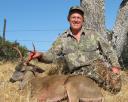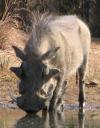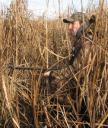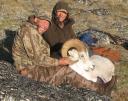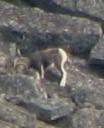 A couple months after the 2006 Buck-O-Rama, I purchased a northern BC Stone Sheep hunt. Having hunted mule deer since I was 21, I wasn’t sure exactly how I’d be getting all the value out of the hunt, because a great mule deer hunt could be purchased for less than one third the price of the sheep hunt. However, I wanted to find out for myself what was so good about hunting sheep. As you’ve probably figured out, sheep hunting is very much like hunting remote-country mule deer with that one major exception. And, if you like, you can hunt great remote-county mule deer on a self-guided hunt for less than a couple thousand dollars.
A couple months after the 2006 Buck-O-Rama, I purchased a northern BC Stone Sheep hunt. Having hunted mule deer since I was 21, I wasn’t sure exactly how I’d be getting all the value out of the hunt, because a great mule deer hunt could be purchased for less than one third the price of the sheep hunt. However, I wanted to find out for myself what was so good about hunting sheep. As you’ve probably figured out, sheep hunting is very much like hunting remote-country mule deer with that one major exception. And, if you like, you can hunt great remote-county mule deer on a self-guided hunt for less than a couple thousand dollars.
The out-the-door cost of my two week 2006 BC stone sheep hunt was almost exactly $25,000, not including equipment costs. My typical mule deer hunt costs between $100 and $2,000. This last fall, I archery hunted mule deer in Alberta for a week and paid about $7,000 including all costs.
Although I’ve never paid for a two-week pack trip to hunt trophy mule deer, I’d imagine that a exceptional two week wilderness deer/elk hunt could be had for $10,000 including travel. Not all sheep hunts cost $25,000 either, but that is a good representative number. I’ve had many questions asked since the returning from the hunt, most of them from my spouse, Linda.
“What did you get for your $25,000?”
“Was it worth it?”
“Would you do it again?”
Worthy questions, but difficult to answer, because I didn’t want to endanger my future hunting options and I can honestly say that I didn’t attempt to compare hunts from a financial perspective. Why not? Because that’s what the hunt cost and I decided to do it. In retrospect, I’m now much more prepared to evaluate the situation than I was before the hunt.
 What did I get for my $25,000? I got travel from my front porch to a remote wilderness camp at the base of a BC mountain where several legal stone sheep rams resided. To get there I traveled in a limousine (one hour), 737 commercial jet (five hours), pickup (two hours), float plane (half hour) and on horseback (four hours). After that came the hiking and there was plenty of that as well. Naturally, the process was reversed for the return trip. There were many meals, about 50 of them, ranging from steak and eggs to moose meat sandwiches with great home baked bread, rolls and pies. But, I didn’t go there to eat.
What did I get for my $25,000? I got travel from my front porch to a remote wilderness camp at the base of a BC mountain where several legal stone sheep rams resided. To get there I traveled in a limousine (one hour), 737 commercial jet (five hours), pickup (two hours), float plane (half hour) and on horseback (four hours). After that came the hiking and there was plenty of that as well. Naturally, the process was reversed for the return trip. There were many meals, about 50 of them, ranging from steak and eggs to moose meat sandwiches with great home baked bread, rolls and pies. But, I didn’t go there to eat.
My entourage included outfitter, guide, wrangler, cook and assistant – not to mention the concession owner who tagged along and helped out for about half the trip. I’ve never had so much attention. And, with the four hours a day of horseback riding for eleven days in a row, I needed all the help I could muster to get on and off my pony. What did this entourage do? They did everything, but dress me and wash me.
Meals were all prepared and coffee brewed constantly. When I needed a horse, it was ready. These people made sure that I had all the support necessary to make sure I would have my best chance to bag a ram when the opportunity presented itself. That’s all I could have asked for. To be valid, the outfitter had to provide me with a legitimate chance to bag a ram.
That was the case. In fact, we found a legal ram the first day out of camp. We spent the first four days attempting to get in position to stalk the ram and take him with archery equipment. On day four, it looked as though we would finally get into position for a chance with my bow. However, the legal ram and six younger rams with him moved off before I could get into position. I spotted them at 100 yards, staring in my direction as I stalked the spot where they had been.
After four days of failure, I reconsidered my prospects for taking a ram with bow and arrow and elected to switch to the 300 magnum. On day six, I connected with a beautiful ram. On the remainder of the hunt I searched unsuccessfully for a mountain caribou to shoot with my bow. I think that answers the first question.
“Was it worth it?”
My best answer for that came from my mother who told me she never regretted the things she’d done, only the things she’d not done. That statement covers it for me, but there is more. Each activity or action we undertake becomes part of the richness of our life. If you can find a way to afford a trip like this, by all means take it. There’s nothing that can replace the first-hand experience of a wilderness hunt for sheep.
For those who decide they don’t think the product justifies the price, go mule deer hunting and don’t look back. In my opinion, mule deer are every bit the quarry that sheep are. Hunting mule deer is not sheep hunting, but it’s very similar and can be every bit as satisfying, challenging and exciting.
Mule deer are sheep with a little less sizzle.
And the last question,
“Would you do it again?”
Since my return, people keep referring to my sheep hunt as “the trip of a lifetime.” Mistakenly, I used to think that meant that I could go only once. Lately I’ve realized that “trip of a lifetime” only means it’s the trip of a lifetime so far.
 Caption: The first ram was the smallest, the second was almost legal and the third is the one I eventually shot. The photo was taken from about 600 yards about two hours before the shot.
Caption: The first ram was the smallest, the second was almost legal and the third is the one I eventually shot. The photo was taken from about 600 yards about two hours before the shot.




